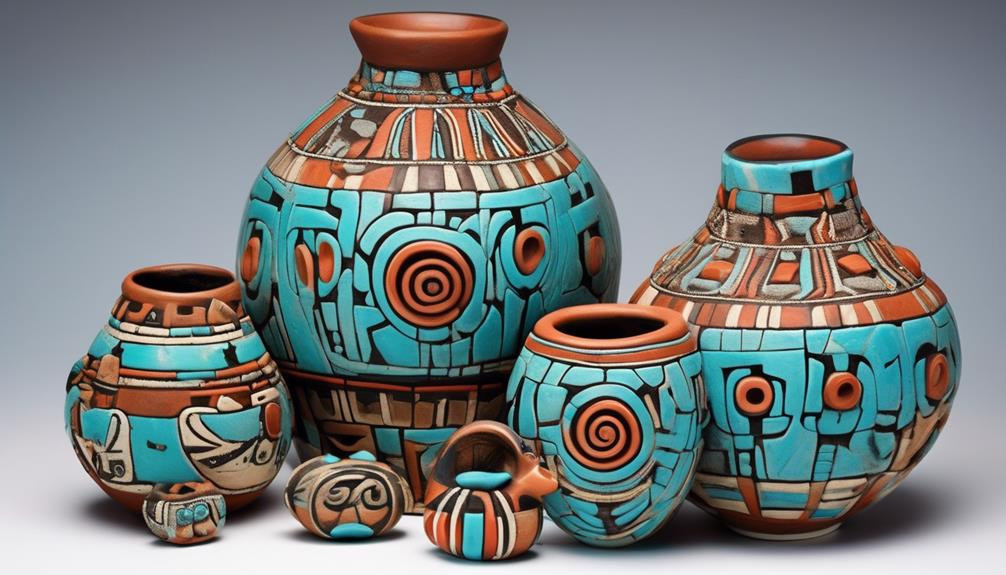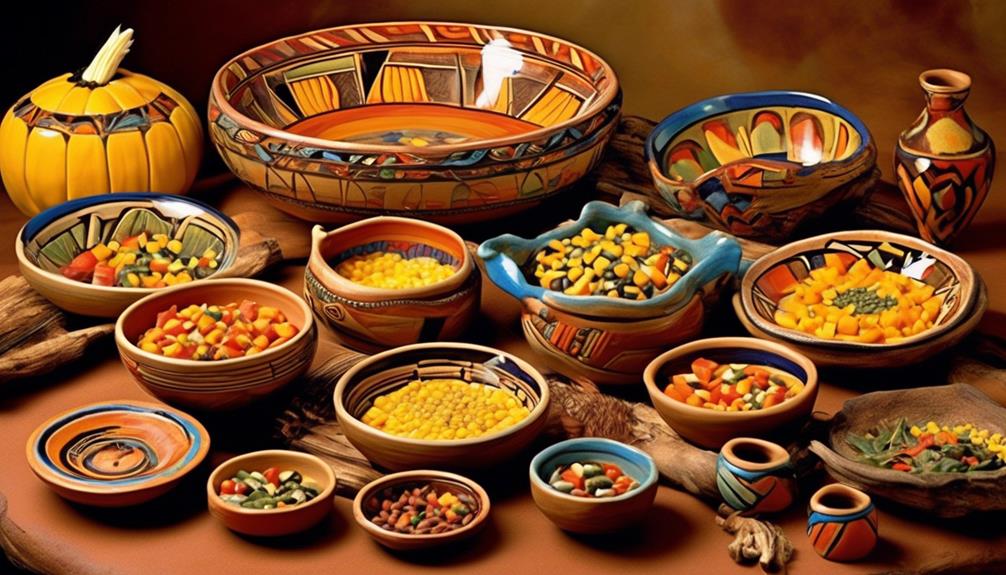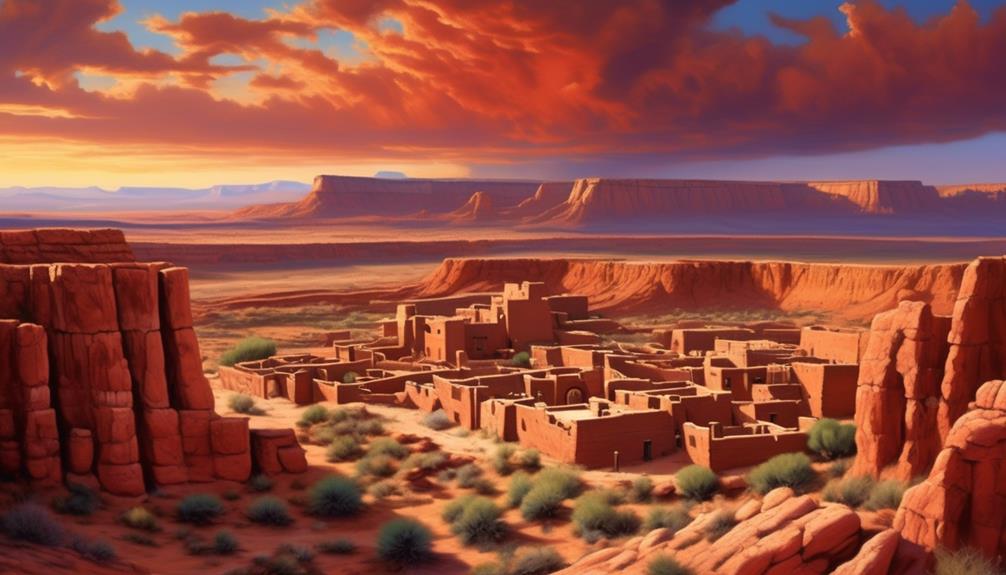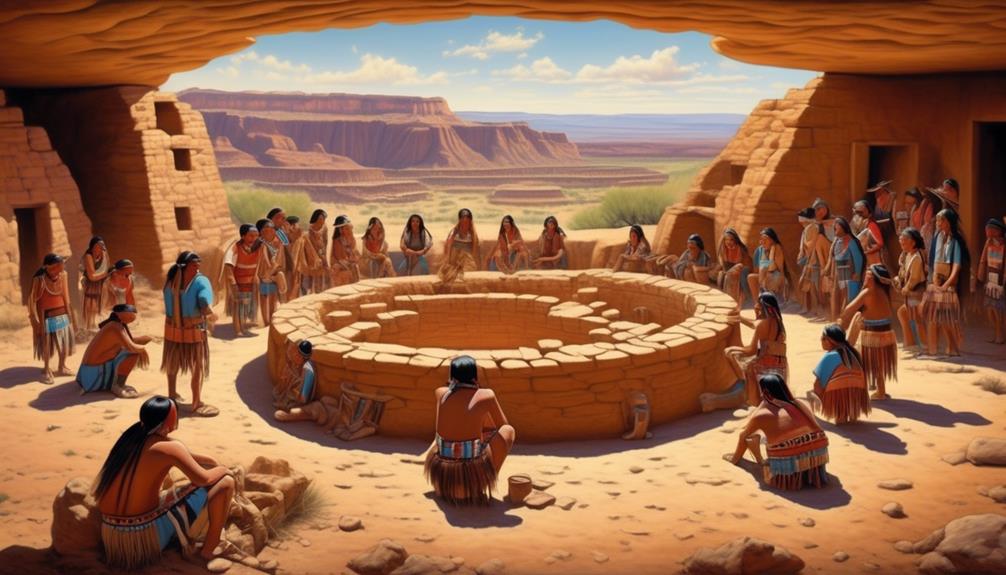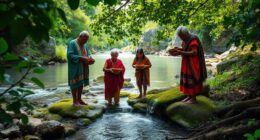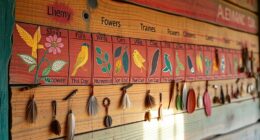Have you ever pondered on how ancient civilizations conducted financial transactions without our current modern currency system?
The Hopi tribe, nestled in the Southwest region of the United States, had a unique system of trade and commerce that differed significantly from the concept of money as we know it today.
Their method of exchange and value attribution was rooted in the intrinsic worth of goods rather than the exchange of coins or paper currency.
This distinctive approach to economic transactions offers a fascinating insight into the Hopi culture and their intricate system of trade, which continues to captivate historians and anthropologists alike.
Key Takeaways
- Barter economy plays a central role in the Hopi tribe's daily transactions.
- Maize (corn) is used as a reliable medium of exchange, symbolizing fertility and life.
- Pottery serves as a medium of exchange, with intricately designed and skillfully crafted pieces having higher value.
- Livestock is an integral part of the Hopi tribe's economy and cultural interconnectedness, used for bartering and strengthening social ties.
Hopi Barter Economy
In the Hopi community, barter economy plays a central role in daily transactions, facilitating the exchange of goods and services without the use of conventional currency. This traditional economy, based on the barter system, is deeply rooted in the cultural and social fabric of the Hopi tribe. Unlike modern monetary systems, the Hopi barter economy relies on the exchange of goods such as corn, beans, and pottery, as well as services like farming or craftsmanship, rather than using standardized currency.
The barter system within the Hopi tribe is a reflection of the community's values and interconnectedness. It fosters relationships and solidarity among community members and reinforces the communal nature of the Hopi society. This traditional form of economy also serves as a way to preserve and pass on cultural practices and traditions from one generation to the next, as the exchange of goods and services is often accompanied by storytelling and sharing of knowledge.
Compared to modern economies, the Hopi barter system highlights the sustainable and self-sufficient nature of the tribe's economic practices. It emphasizes the utilization of local resources and the importance of reciprocity, contributing to a harmonious coexistence with the natural environment.
Intrinsic Value of Goods
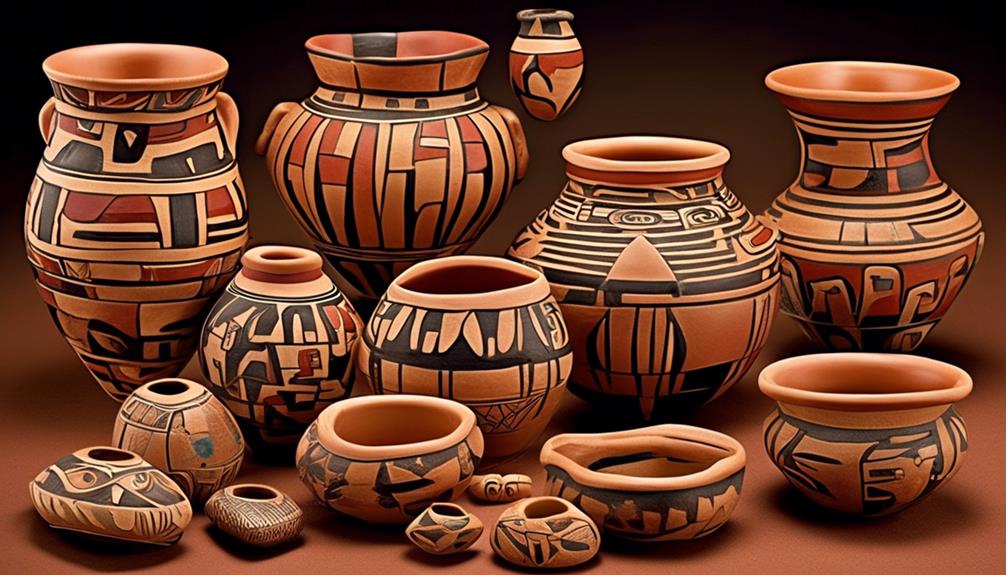
The cultural and social significance of the Hopi barter economy is inherently tied to the intrinsic value of goods exchanged within the community. In traditional trading practices, the intrinsic value of goods goes beyond their physical attributes, encompassing their cultural, spiritual, and utilitarian significance.
- Cultural Significance
- The Hopi people place great importance on the cultural significance of goods. Items such as handcrafted pottery, kachina dolls, and woven baskets hold deep cultural value, representing ancestral traditions and spiritual beliefs.
- Spiritual Value Exchange
- Traditional trading practices among the Hopi involve the exchange of goods with profound spiritual significance. Items used in religious ceremonies, such as prayer feathers, ceremonial masks, and sacred herbs, hold intrinsic value that transcends material worth.
- Utilitarian Significance
- While cultural and spiritual aspects play a significant role, the utilitarian value of goods is also crucial. Tools, agricultural produce, and livestock are exchanged based on their practical utility within the community, demonstrating the multifaceted nature of intrinsic value in the Hopi barter economy.
The intricate interplay of cultural, spiritual, and utilitarian values shapes the intrinsic worth of goods in the Hopi barter economy, highlighting the depth and complexity of traditional trading practices.
Corn as Currency
Corn, a staple crop in the Hopi tribe's agricultural tradition, holds a unique and integral role as a form of currency within their barter economy. The use of corn as currency is deeply rooted in the Hopi culture, where maize trade was not only a means of exchange but also a symbol of fertility and life. The agricultural currency system enabled the Hopi people to establish trade relationships, acquire goods, and foster social connections within and beyond their community.
| Maize Trade | Agricultural Currency |
|---|---|
| Essential trade item | Integral part of barter economy |
| Symbol of fertility and life | Facilitated social connections |
The maize trade was essential for the Hopi tribe's survival, and corn served as a reliable medium of exchange due to its intrinsic value and significance in their daily lives. The use of corn as a form of currency also fostered a sense of interconnectedness and reciprocity among the Hopi people and neighboring tribes. Furthermore, the agricultural currency system allowed for the equitable exchange of goods and resources, contributing to the sustainability of the Hopi community.
Pottery and Trade
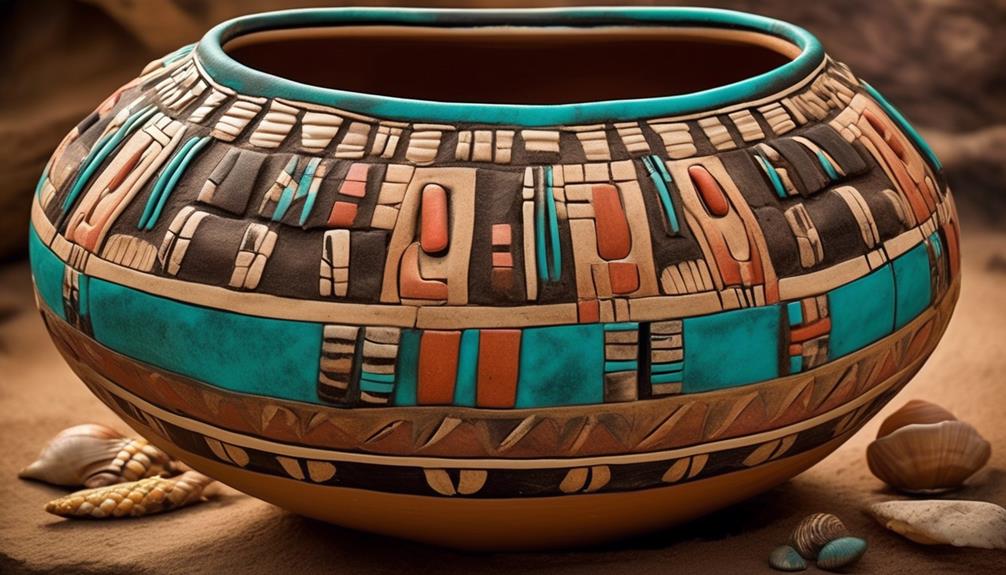
Pottery, like corn, played a pivotal role in the Hopi tribe's economic interactions, serving as a valuable commodity in their trade networks. The exchange of pottery wasn't merely a means of economic transaction but also held deep cultural significance within the tribe.
- Economic Significance
- Pottery served as a medium of exchange in trade, with intricately designed and skillfully crafted pieces often commanding higher value, especially when traded with neighboring tribes.
- Different types of pottery, such as plainware and decorated pottery, held varying levels of economic value, allowing for a diverse range of trade options within the tribe's network.
- The production and trade of pottery contributed to the tribe's economic sustainability, as skilled potters were highly esteemed and their creations were in constant demand.
- Cultural Significance
- Pottery held symbolic value within the Hopi tribe, often reflecting their spiritual beliefs and ceremonial practices.
- The exchange of pottery was deeply intertwined with social and cultural ceremonies, strengthening interpersonal relationships and fostering unity within the tribe.
- Each unique pottery design and style represented a link to the tribe's history and traditions, making it an integral part of their cultural identity.
The exchange of pottery within the Hopi tribe not only facilitated economic transactions but also served as a vessel for preserving and showcasing their rich cultural heritage.
Livestock Exchange
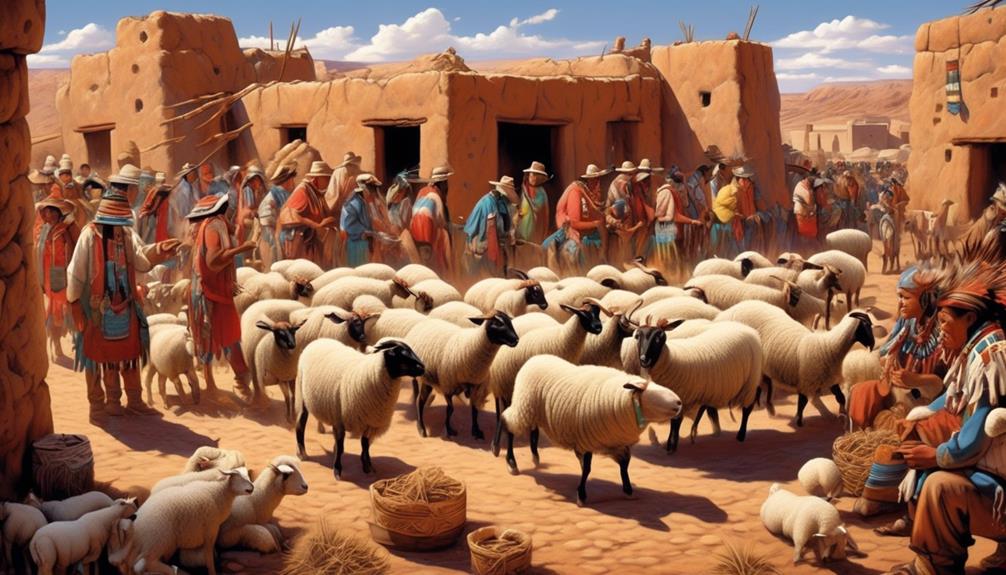
Engaging in trade with neighboring tribes and utilizing our livestock as valuable assets has been integral to the economic sustainability and cultural interconnectedness of the Hopi tribe. Livestock bartering holds immense cultural significance for the Hopi people, as it not only serves as a means of economic exchange but also plays a vital role in ceremonial and social contexts. The exchange of livestock such as sheep, goats, and cattle has been a longstanding practice among the Hopi tribe, reflecting our deep-rooted connection to the land and our reliance on traditional agricultural practices.
| Livestock | Trade Value | Cultural Importance |
|---|---|---|
| Sheep | Highly Valued for Wool and Meat | Integral to Ceremonial Practices |
| Goats | Valued for Milk and Meat | Symbol of Fertility and Abundance |
| Cattle | Important for Labor and Trade | Associated with Prosperity and Wealth |
Livestock bartering not only facilitates economic transactions but also strengthens social ties and fosters unity among neighboring tribes. The cultural significance of livestock exchange is evident in the role of livestock in traditional ceremonies and its representation of abundance, fertility, and prosperity within the Hopi community. This practice underscores the interconnectedness of economic and cultural aspects within our tribe, emphasizing the enduring value of livestock beyond mere financial transactions.
Frequently Asked Questions
How Did the Hopi Tribe's Barter Economy Differ From the Modern Concept of Money?
In a barter economy, the Hopi tribe engaged in cultural exchange and trade rituals to acquire goods and services, contrasting with modern currency-based systems. Instead of using money, they relied on a system of exchanging goods directly, fostering community bonds and social connections.
This differed from the modern concept of money, which relies on a standardized medium of exchange. The Hopi's barter economy emphasized interpersonal relationships and cultural significance in their trade practices.
What Role Did Spiritual Beliefs Play in the Intrinsic Value of Goods Within the Hopi Tribe's Economy?
In the Hopi tribe's economy, spiritual beliefs played a pivotal role in shaping the intrinsic value of goods. This differed significantly from the modern concept of money.
In their barter economy, items held deep spiritual significance, influencing their worth. This contrasts with the purely material value assigned in modern economies.
The Hopi's unique approach to value demonstrates the profound impact of spiritual beliefs on their economic system.
Were There Any Specific Rituals or Ceremonies Associated With the Use of Corn as Currency Within the Hopi Tribe?
Ritual ceremonies associated with corn currency held significant economic and spiritual significance within the Hopi tribe. These ceremonies symbolized the interconnectedness of trade practices and spiritual beliefs.
Corn, as a form of money, played a pivotal role in the Hopi's barter system, reflecting the tribe's reverence for agriculture and nature.
The ritualistic use of corn currency underscored the tribe's unique trade practices, emphasizing the intrinsic value of goods within their economy.
How Did the Hopi Tribe's Pottery Production Contribute to Their Trade With Other Tribes?
Pottery trade and intertribal commerce thrived due to the Hopi tribe's exceptional pottery production. Their unique styles and craftsmanship made their pottery highly sought after, leading to extensive trade relationships with neighboring tribes.
The intricate designs and durable quality of their pottery set them apart in the intertribal market, enabling the Hopi to acquire valuable resources in exchange for their prized ceramic wares.
This cultural exchange through pottery trade significantly influenced the tribe's economic and social standing.
Did the Hopi Tribe Have Any Specific Customs or Traditions Related to the Exchange of Livestock in Their Economy?
In the Hopi tribe, livestock exchange was a crucial economic custom. This practice was deeply intertwined with their spiritual beliefs and trade ceremonies.
Livestock, such as sheep and cattle, played a significant role in their economy, symbolizing wealth and sustainability. The exchange of livestock wasn't just a transaction but a sacred tradition, strengthening social bonds and ensuring the prosperity of the community.
Conclusion
In conclusion, the Hopi tribe used a barter economy, where goods and livestock held intrinsic value and were exchanged for other items.
Interestingly, corn was a widely used form of currency, with 20 ears of corn being equivalent to one blanket.
This unique system allowed for the exchange of goods and services within the tribe, showcasing the resourcefulness and ingenuity of the Hopi people.
